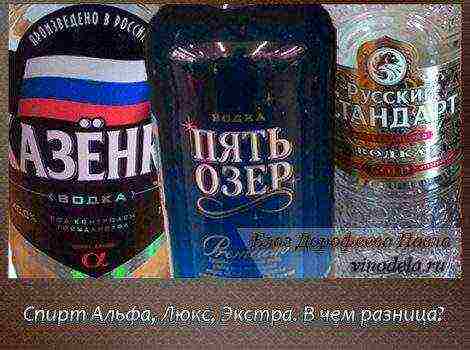Content
- 1 Unabi-ziziphus: what an exotic
- 2 Description of popular varieties of ziziphus
- 3 Reviews of gardeners about unabi
- 4 Ziziphus tree: photo and description of leaves, flowers and fruits
- 5 The most famous plant varieties Ziziphus
- 6 Planting and caring for ziziphus in the open field, taking into account the frost resistance of the tree
- 7 Propagation of ziziphus by seeds and cuttings
- 8 Planting and growing ziziphus at home
- 9 Unabi-ziziphus: what an exotic
- 10 Description of popular varieties of ziziphus
- 11 Reviews of gardeners about unabi
This plant will be a real gift for a gardener who loves exotic beauty and cares about his health. The Chinese date, also known as unabi and ziziphus, is a tree or shrub, which is distinguished by its original appearance. And its fruits are not only very tasty, but also healthy. In addition, the leaves, even the bark and roots of unabi, contain medicinal substances. It can grow on the poorest land, it does not need special care. Although there is a significant problem - the Chinese date is too thermophilic, and not all varieties tolerate Russian frosts without loss. Therefore, until recently, unabi were grown only in the southern regions. But if you choose the right variety, you can get your own dates in harsher climates.
Unabi-ziziphus: what an exotic
For most of us, unabi is an exotic plant. However, in the East he has been known for a long time. According to some sources, in China and India, zizyphus was domesticated two thousand years ago. A little later, they began to grow it in Mediterranean countries. And only in the last century, the Chinese date began to grow in Uzbekistan, Turkmenistan, Transcaucasia, Krasnodar Territory, Crimea and southern Ukraine.
Unabi is the champion in terms of the number of titles. In different countries, he acquired not one, but several names at once. In total, there were about a dozen of them: ziziphus, jujuba, jujuba, chapyzhnik, chailon, anab, chilion, jilan dzhida, planjiba, zao, yanap (or anab), arnap, ilan dzhida. In France, the plant is called breast berry, and in Russia, the Chinese date.
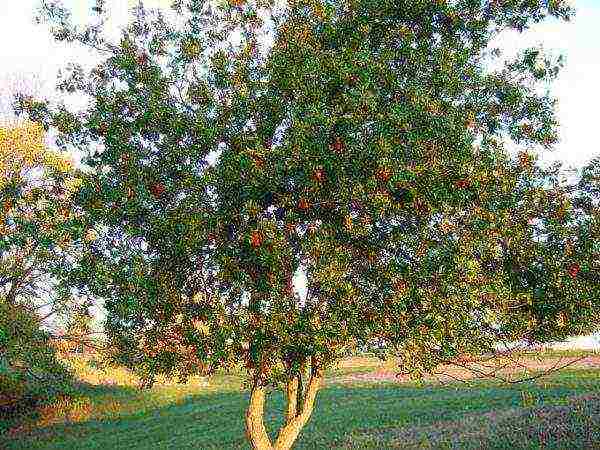
In China, unabi is called the tree of youth for the ability of its fruits and leaves to rid the body of toxins, cholesterol, cleanse blood vessels and strengthen capillaries
The native climate for unabi is the tropics and subtropics. For a long time it was believed that this plant does not survive and does not bear fruit in central Russia. But in recent years, more winter-hardy forms have appeared, and gardeners have adapted to growing thermophilic exotics in a continental climate.

New cold-resistant forms of the subtropical Chinese date can also be grown in the middle lane
The Chinese date in culture is a small deciduous tree (up to 5 meters) or a tall shrub.On slightly drooping shoots, there may be rare thorns. Leaves are oval, with characteristic longitudinal veins. The crown is harmoniously shaped, pyramidal or spherical. Unabi is distinguished by a late start of the growing season. The plant wakes up by mid-May and even a little later. Therefore, return frosts are not afraid of him.
Most varieties of Ziziphus need cross-pollination, so 2-3 trees should be planted side by side to get a good harvest.
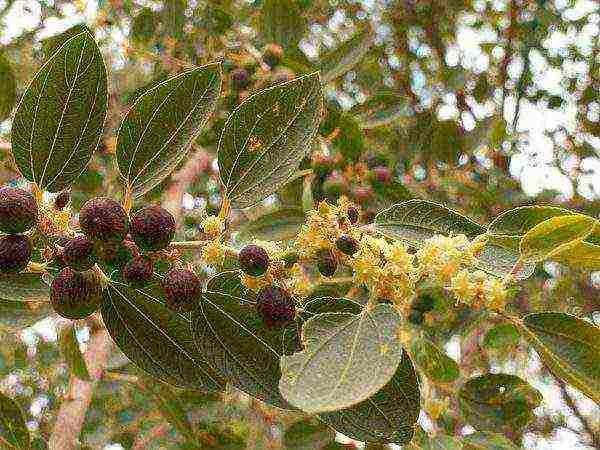
On the same branch, a ziziphus can have flowers and fruit ovaries.
Unabi bloom is extended, greenish-yellow flowers bloom for one and a half to two months. They're not very good looking, but they smell great. Bees find this smell very attractive. The fruits are tied and ripen unevenly: the former can ripen by the end of summer, the latter in October, or even in December. If the autumn is rainy, the harvest is harvested unripe, and the ripeness of the unabi picks up later; in dry autumn, gardeners recommend not to rush to harvest, but to let the fruits wither on the branches - then they become tastier. By the way, up to 25 kg of harvest can be removed from one adult tree, and there are record-breaking varieties that yield 80 kg each.
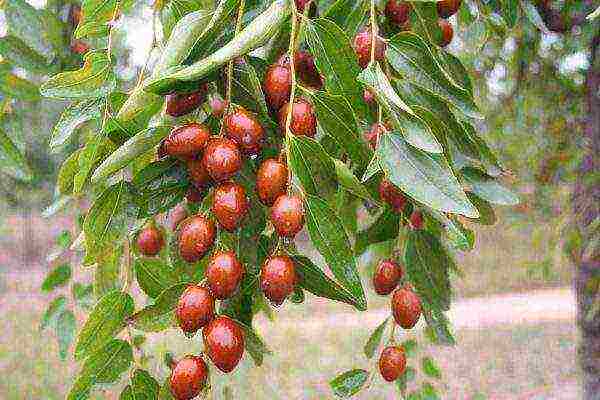
Most unabi varieties give high yields.
The fruits of different varieties of unabi differ significantly from each other. Their weight ranges from 2.5 to 35 grams. The shape can be spherical, oval, pear-shaped. Color from red-orange to chocolate brown. On the skin of some varieties, light specks are visible. Ripe fruits are tender and juicy. The pulp, sometimes mealy, sour and sweet tastes are combined in different variations. The stone is small, in some varieties it does not develop completely, remaining semi-soft.

Dried unabi fruits are very similar to real dates.
The Chinese date (or unabi) has nothing to do with the real date. The plant got its popular name due to the external similarity of the fruits and a slightly similar taste.
Unabi fruits are eaten fresh, they are used for making preparations (compotes, jam, syrup, candied fruits) or dried. In any form, Chinese dates are good for your health. They contain more ascorbic acid than citrus fruits, as well as flavonoids, pectin, carotene, rutin, iodine, cobalt and other elements.
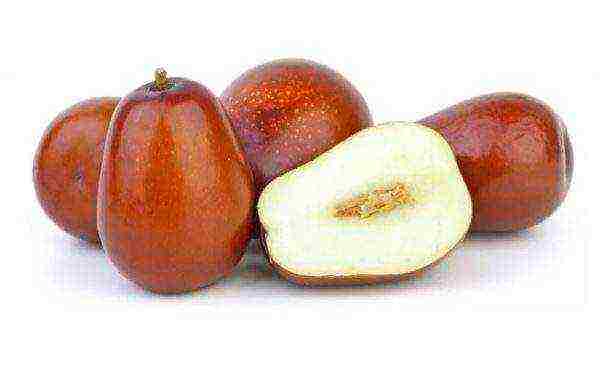
Fruits of different varieties differ in color and size, but are equally useful
Ziziphus fruits help with respiratory diseases, hypertension, anemia, vitamin deficiency. To lower blood pressure, Chinese doctors advise eating 20 fresh or dried dates three times a day after meals. The fruit decoction soothes and helps restore healthy sleep.
Birds can nibble on unabi crops. To protect it, a net is thrown over the trees.

Sweet and sour ziziphus fruits resemble dates, pineapple and pear at the same time
From the leaves of unabi, bark and roots (rich in tannins, saponins and rutin), healing agents are also prepared, which are used internally and externally. The broth has a diuretic, expectorant and antibacterial effect.
Video: why unabi (ziziphus) attracts gardeners
Description of popular varieties of ziziphus
There are about forty species of plants of the buckthorn family in the Unabi genus. On the basis of the present zizyphus, most cultivars have been bred, which are divided into two groups according to the size of the fruits (small and large-fruited). Unabis were selected by Chinese, Central Asian, Krasnodar and Crimean biologists. Scientists have noted a number of interesting features. For example, they found that small-fruited plants contain more vitamin C and tolerate lower temperatures better. Larger varieties are sweeter. But the size does not affect the yield. Unabi are divided into three groups according to the ripening time of the crop: early, middle, late.
Early
From trees of early varieties, they begin to harvest at the end of August, and end in September. These dates are mostly small to medium sized. Large-fruited early varieties are rare.
Vakhsh
Bred by Tajik breeders.The tree is tall (4–5 meters), with a pyramidal crown, medium-sized fruits (up to 18 g), ripen in mid-September. They resemble a cylinder, with a light chocolate skin. The variety has a high yield.

Vakhsh is an early and high-yielding variety of unabi
Maury Jer
Ziziphus of the Mori Jer variety is the result of the labors of breeders from Moldova. The tree itself is medium in size, and the fruits are large (up to 35 g), elongated-cylindrical. They are gaining ripeness by the second decade of September. The plant can withstand temperatures as low as -25 ° C.
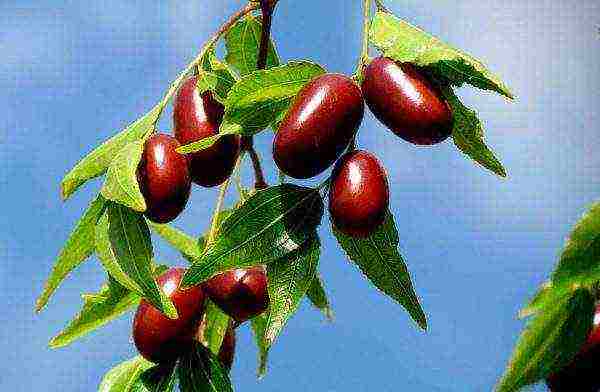
Mori Jer unabi can withstand short-term frosts
Chinese 60
This is one of the smallest unabi varieties. Crown diameter - no more than one and a half meters, height - up to 3 m. Fruits are elongated, slightly pointed at the top and bottom, small and medium-sized (up to 12 g), covered with a brown-plum skin. They taste sweet and sour. The crop is ready to be harvested in mid-September.
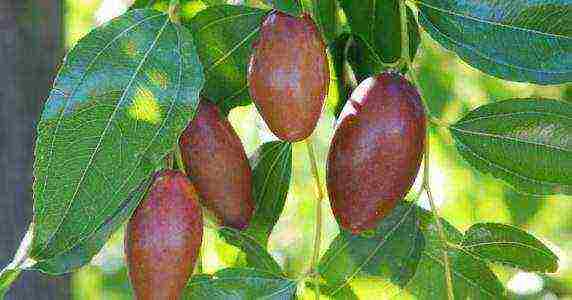
Chinese 60 is the most compact variety with spindle-shaped fruits
Candy
This unabi gives stable and high yields by mid-September. The tree is low, with a spherical crown. The fruits are small, weighing only 6–8 g, but there are usually so many of them that you cannot see the greenery. The thin, brick-red skin covers the very sweet and juicy flesh.
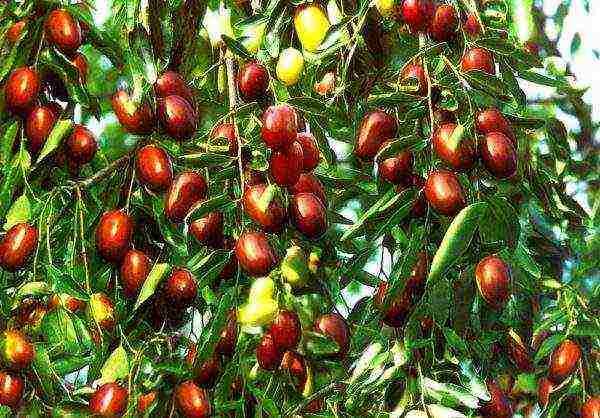
The Candy variety justifies its name with an abundance of sweet fruits.
Sinit
Ziziphus variety, bred by scientists of the Nikitsky Botanical Garden. A tree of medium height with a branched crown. Fruits are medium-sized (up to 6 g), but ripen at a record early date. Cinita is harvested in late August or early September. The stone is small, sour-sweet flesh hides under a brown strong skin. The fruits are good fresh, suitable for drying and canning.

Crimean variety Sinit gives a record early harvest
Khurman
This is one of the most productive and at the same time large-fruited varieties of unabi. From flowering to ripening, an average of 80 days pass. The collection of fruits takes 2-3 weeks. The warmer and sunnier the summer was, the sweeter this Chinese date will be.
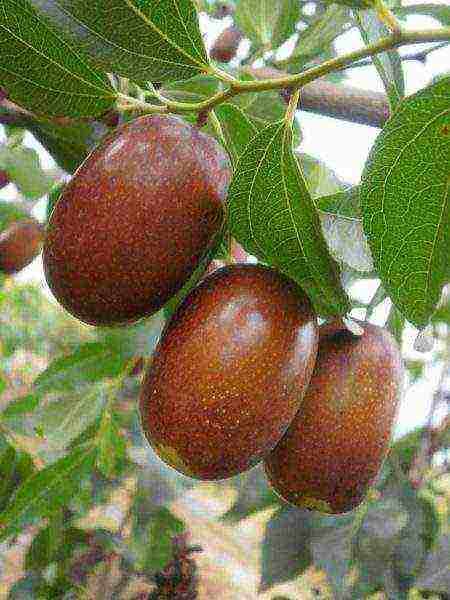
Large fruits of the Khurman variety, which ripen very early, can be harvested for 2-3 weeks
Southerner
The author of this variety is the breeder Massover BL Zizifus grows up to 4 meters. The crown of the tree is spreading. Pale brown large fruits (up to 20 g) in appearance slightly resemble a pear: at the top they are narrower than below. The pulp is a little dry, but the taste is pleasant, sweet, with a slight sourness. The Southerner variety is fruitful. The fruits are stored after drying for several months.
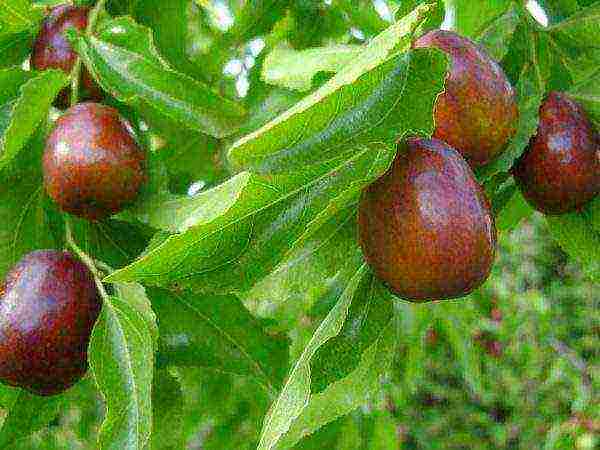
The pear-shaped unabi fruits of the Yuzhanin variety are dryish, but they are stored for a long time
Ta-Yan-Zao (other names - Lang, Chinese 1)
Early (reaches ripeness in the second half of September) and large-fruited unabi from China. One of the first cultivars. This vigorous, branched tree begins to bear fruit in the 2-3rd year. Dates are large, average weight 15 g, maximum - 35. In shape, they are similar to miniature pears, yellowish or brown with a red tint. The taste is sweet, the pulp contains up to 35% sugar. Very often the fruit has no bone or it is poorly developed. The yield is average. Ta-Yan-Zao is very sensitive to moisture. Due to rainy weather, the fruits become too juicy and cracked.
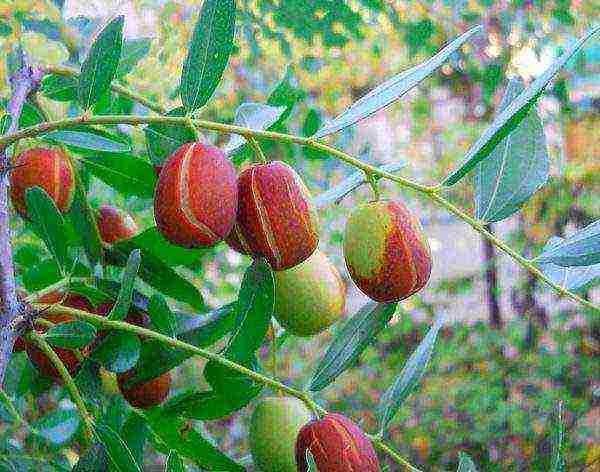
The name of the variety Ta-Yan-Zao in translation from Manchu means "be healthy"
Video: acquaintance with ultra-early unabi growing in Belarus
Mid-season
Chinese dates of these varieties pick up sweetness and are ready to leave the tree at the very end of September or October. They produce medium to large fruits. Low temperature resistance for most of these varieties is average.
Shirvan
This variety was bred in Central Asia. Fruits are small (average weight 3.5 g), barrel-shaped. The color of the skin is pale brown, the flesh is dense, milky-chocolate, sour-sweet. The variety gives high yields.
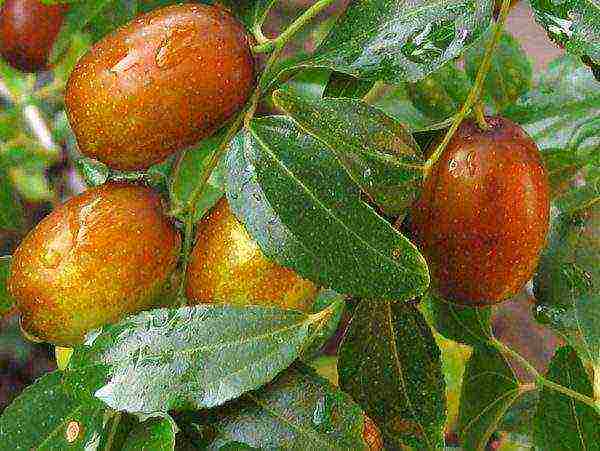
The Shirvansky variety gives very beautiful, but small fruits.
Absheron
Ziziphus Apsheronsky was created by Krasnodar breeders.They managed to develop a fruitful and frost-resistant variety for their region. The average weight of the fruits is 6–8 g. They are chocolate-brown in color and resemble real dates. The pulp is tender, vanilla shade, the taste is bright, combining sweetness and slight sourness. The full maturity of the fruits occurs by the second half of October.
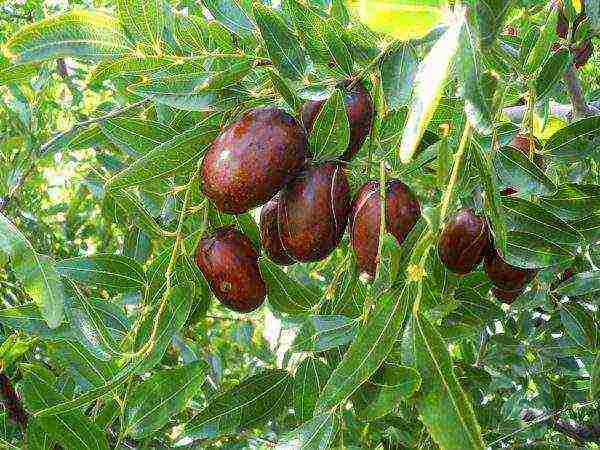
Apsheronskiy is a variety of Russian selection with a bright fruit taste, similar to real dates
Chinese 2A (or 52)
A proven variety with nearly a century of history, it is well known in the world. From China first came to America, and only then to Russia. Large (up to 25 g) fruits ripen by the end of October. When ripe, oval-elongated dates acquire a rich chestnut color. The light pulp is juicy and sweet. The sour taste is poorly expressed.
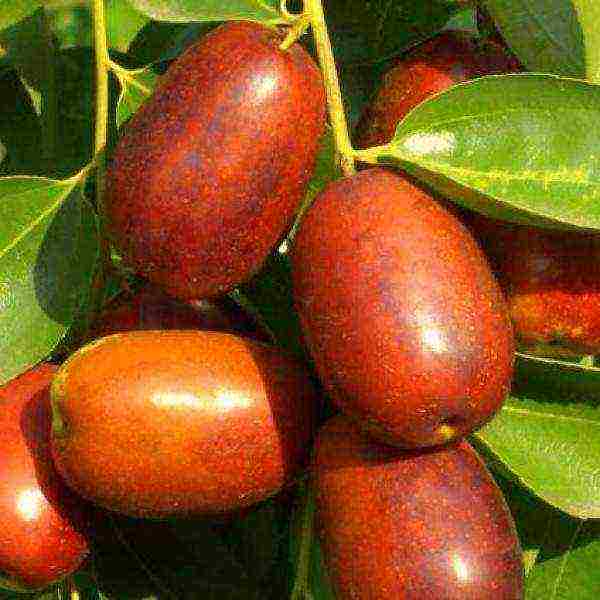
Chinese 2A - one of the first cultivated varieties of unabi
Soviet
The medium-ripening variety was bred by botanists of Tajikistan, spread in Central Asia. Now you can buy it in Russian nurseries. Elongated-rounded fruits weigh on average 15–20 g. They are light brown in color. The pulp has a delicate consistency, harmonious taste. The disadvantage of the variety is that with high humidity during ripening, the fruits may crack.
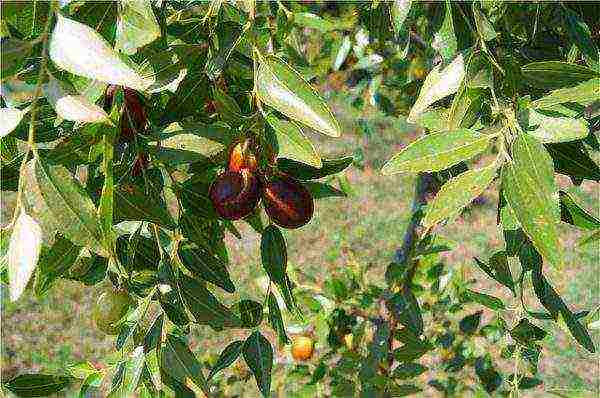
Delicate soft fruits of the Soviet variety can crack with excess moisture
Tasty
The trees of this variety of Ziziphus grow very quickly. The fruits are large, up to 35 g in weight, ripen in October or November. Under the light brown skin, there is a sweet creamy flesh. The yield and frost resistance of the Lakomiy variety are average.
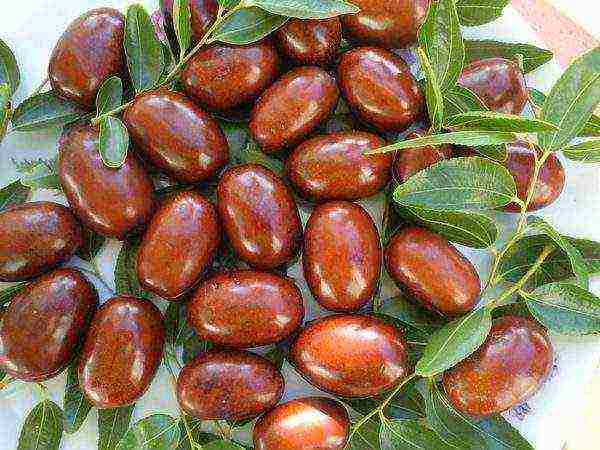
A fast-growing tree of the Lakomyi variety bears large fruits
I-Zao
This Chinese variety cannot boast of large fruits, their weight is usually no more than 7 g. But its advantage is abundant harvests. There are no thorns on a tall tree, and by mid-October the branches are hung with fruits, the color of which gradually becomes chestnut. Their greenish flesh has a pleasant sweet-sour taste. The variety is suitable for fresh use, good for harvesting.
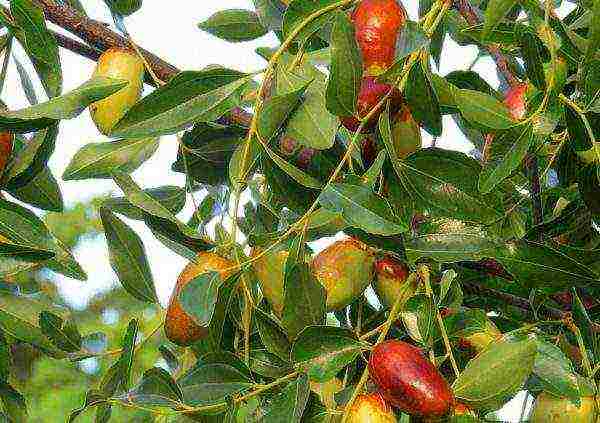
Ya-Zao is a variety that gives a bountiful harvest in almost any conditions.
friendship
One of the newest unabis. The fruits are not the smallest, but not large, the usual weight is 10-15 g. Their shape is pear-like, and the color is unusual - plum-chocolate. The yield is low. The peculiarity of the Druzhba variety is that its resistance to frost is slightly above average.
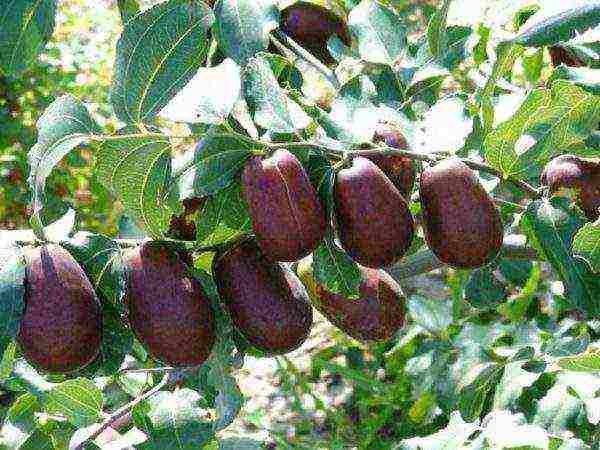
Pear-shaped fruits of unabi Friendship of an unusual color - plum-chocolate
Tavrika
The now popular variety of Ziziphus, which ripens in October. "Dates" Tavriki are spherical or similar to barrels. Their average weight is 12-16 g. Skin color is orange-chestnut. Pulp with a characteristic pleasant taste. This variety is distinguished not only by good resistance to frost, but also by increased productivity.

Frost-hardy Taurica has round, bright fruits
Late
There are not so many varieties of ziziphus, the fruits of which ripen late. It is not very popular because the harvest is delayed until late autumn. It starts at the end of October and ends in November and sometimes in December. It happens that a tree completely sheds its foliage, the first snow falls, and the dates have not yet been collected. Of course, such a tree looks elegant and original. But only gardeners living in the hot south can afford such a luxury.
Kara-Dag
The variety created in Crimea fits well with local conditions. It tolerates dry summers and slightly frosty winters without any problems. Large pear-shaped fruits, their weight can reach 35 g, ripen by October-November. But gardeners are in no hurry to pluck them. They wait for the reddish-chocolate skin to wrinkle slightly. Dried fruits are tastier and sweeter than juicy ones. And besides, they are stored longer.
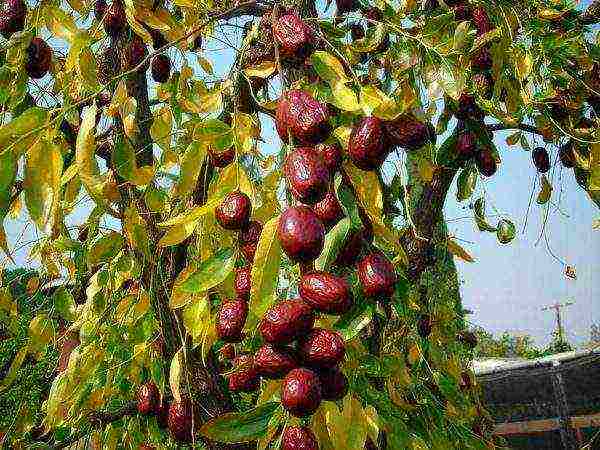
The fruits of the unabi Kara-Dag are left on the tree until the skin wrinkles: this way they become sweeter and last longer.
Koktebel
Another unabi variety with Crimean registration. Breeders of the Nikitsky Botanical Garden can be proud of their pet. Dates of the Koktebel variety grow not just large, but huge, they gain weight up to 50 g.The fruits are round, irregular in shape. Pistachio-white flesh is hidden behind the orange-brown skin. It is not too juicy, but with a delicate sweet-sour taste. But the harvest begins to ripen by the end of October, and northerner gardeners run the risk of not waiting for it. And in all other respects unabi Koktebel is a beautiful strong tree. By the way, its yield is also amazing. The authors of the variety assure that up to 80 kg of fruit can be harvested from an adult plant.
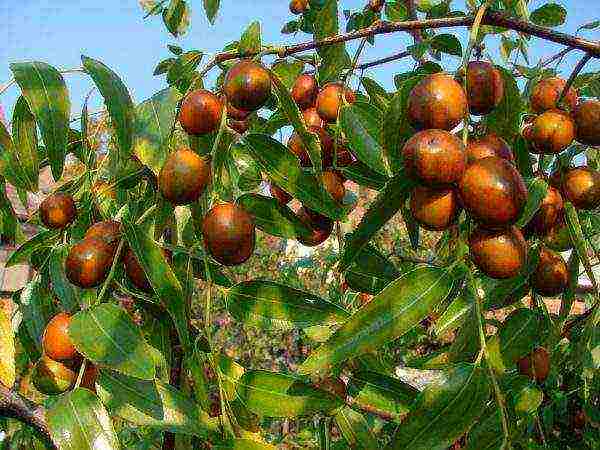
Koktebel is a fruitful, but late variety that can only be grown in the south.
The best varieties of unabi for Crimea
Ziziphus is very fond of warmth and light, he is not afraid of drought. Therefore, this plant feels great on the Crimean Peninsula. The Chinese date will grow even on dry and poor soil. True, lack of nutrition will affect the volume of the crop.

Even in dry summers, unabi fruits will be tasty, but without watering, the harvest will decrease.
Any variety of ziziphus is suitable for Crimean gardens. The gardener only needs to decide what is more interesting for him to grow and when he needs a crop. Of course, the best choice is the late unabis of the Crimean selection. These fruits can be harvested when winter has already come, there will be a wonderful vitamin dessert for the New Year's table. And dried Chinese dates can be eaten until the first summer berries ripen.
Varieties for Ukraine
Almost all varieties of unabi can be grown in the southern regions of Ukraine. Mild winters and long hot summers are what exotics will like. However, the further north you go, the less choice. Late varieties will not be able to harvest until the onset of cold weather. When the frost touches the fruits, they will lose their keeping quality. Therefore, it is necessary to choose unabi with medium or early ripening of fruits. For example, varieties Druzhba, Tavrika, Candy, Apsheronsky, Chinese 60. It is better to give preference to small-fruited varieties. They are more resistant to frost.
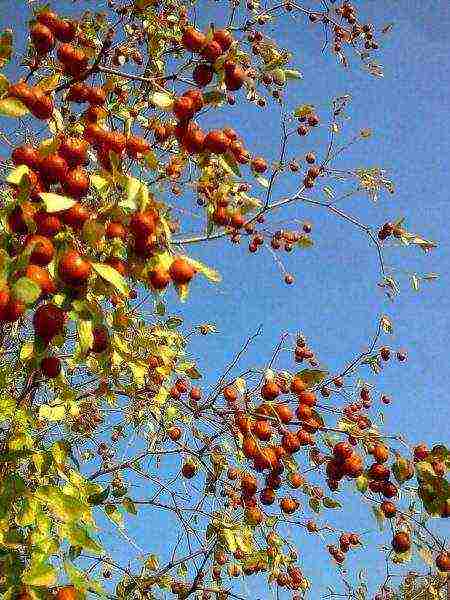
Ziziphus (or unabi) adorns the garden all autumn
In the middle latitudes, cultivation of unabi is associated with certain troubles. First of all, you need to choose the right landing site. It should be well lit and quiet, protected from drafts.
A young tree on the eve of winter must be insulated by tying the trunk and crown with covering material. And the roots must be covered with foliage, grass, and then snow. If the twigs do freeze, the unabi quickly recovers. And with age, the Chinese date becomes more hardy.
Video: how to prepare an unabi seedling for winter
Frost-resistant varieties of unabi for the middle lane
The Chinese date has moved beyond tropical and subtropical regions. It is now cultivated not only in the Crimea, in the south of the Krasnodar Territory and Ukraine. Recently, gardeners living in the Dnepropetrovsk, Rostov, Voronezh regions and even in the Moscow region and Belarus talk about their successes in growing unabi. Although they admit: they have to tinker with a delicate tree, and they do not manage to harvest a good harvest every summer.
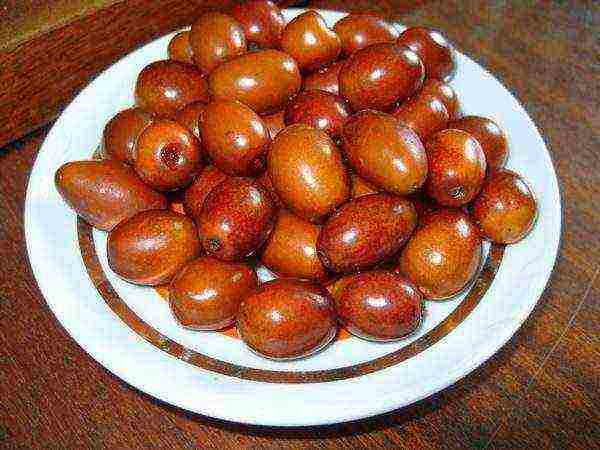
Chinese dates, especially dried dates, can be stored for a very long time.
Experienced gardeners are advised to choose early varieties with small fruits for the middle lane, they are more hardy. It is worth paying attention, for example, to Unabi Chinese 60 and 2A, Khurman, Candy, Yuzhanin, Sinit. And to form from them not a tree, but a bush with a wide crown. Such a plant is easier to prepare for frost.

Unabi fruits can ripen when all the leaves have already fallen
In the event that the fruits do not have time to ripen, the crop will still have to be harvested before the first cold weather. And then put the Chinese dates in storage and wait for ripening.
Video: unabi in cool climates - from planting to harvest
Reviews of gardeners about unabi
Unabi is an extremely useful and beautiful plant, but most gardeners know little about it. It is believed that Chinese dates can only be grown in the south. Indeed, there unabi thrives and bears fruit without much hassle. But it can be cultivated in more northern regions as well. You just need to pay attention to the choice of the variety and put a little work into it.
I am a philologist by education. My hobbies are reading, traveling, caring for my garden and pets. Therefore, much of what I am writing about is not theory at all, but a practice I have gone through personally.
2014-01-27
Ziziphus jujuba, a deciduous tree of the buckthorn family, is one of the most valuable fruit crops in the world. It grows wild from China to the countries of the Eastern Mediterranean. In culture it is cultivated in many countries of the European and Asian subtropical belt. Industrial plantations were established in the USA and some African countries.
As literary sources testify, from time immemorial in the areas of natural distribution of ziziphus lives the confidence of people in its powerful healing effect. They drink a decoction of its fruits to increase vitality and heal from various diseases. In Tajikistan, ziziphus has long been valued by the local population as an edible medicinal plant. Many residents grow it in their yards, in their personal plots, and carefully look after it, as they consider it a sacred tree.
In the wild, zizyphus is found in the form of small tracts and groves, which for centuries have been considered holy places, people believe in their holiness and miraculous power. Ziziphus is no less popular in Chinese medicine: among twelve elite plants it is in fifth place, it is used as a medicine on its own and in collections, as well as to harmonize herbs in a decoction. The main focus of the ziziphus culture is Central China, although it is spread throughout the country, except for the northern regions.
According to literary data, he entered the culture four thousand years ago. To date, there are about four hundred varieties of ziziphus. In China it is called "zao", which simply means "date". We call it "Chinese date" to distinguish it from the fruit of the date palm. In different regions of the world zizyphus is called differently: jujuba, unabi, rem, chinese date, chillon, jilan-jida, French breast berry, etc.
When cultivated varieties of ziziphus were brought to the former USSR in the 1930s, the name “zhuzhub” was proposed, but it did not take root. It is sometimes called "jojoba" in print, but it is a completely different plant used in cosmetics. In the spring of 1953, the seven best varieties and forms of ziziphus were brought from China to the Crimea - to the Nikitsky Botanical Garden. Planting of zizyphus (experimental plantings) began in 1973 in ten Crimean farms, where plots ranging from 0.5 to 3 hectares were allocated. These works were supervised by a researcher of the Nikitsky Botanical Garden, Lydia Timofeevna Sinko. To date, the collection of the Nikitsky Botanical Garden contains 140 specimens, varieties and forms of ziziphus.
Zizyphus was tested in four different soil and climatic regions of Crimea: the Central steppe zone, the Western coastal steppe zone, the Eastern steppe zone, and the South Coast zone. The data obtained indicate that some varieties of ziziphus in certain regions of the Crimea are suitable for industrial cultivation. Naturally, amateur gardeners have a better chance of successfully growing it in their backyards, summer cottages and garden plots, where they can use the microclimate of the site or even create it.
In my garden in Feodosia, ziziphus has been growing for 20 years. For all these years, I did not find any damage to the trees, I tested 18 varieties of ziziphus from the collection of the Nikitsky Botanical Garden. The trees bear fruit every year, the yield grows from year to year. All varieties (early and late) have time to mature.
I will give a description of the best varieties of my garden, using the research data of the scientists of the Nikitsky Botanical Garden, the authors L. T. Sinko and T. V. Litvinova and my own observations.

Ta-yang-tsao (translated from Manchu means "Be healthy"). Synonyms: Lang, Chinese 1. Without a doubt, this is one of the best industrial large-fruited high-yielding varieties of Chinese origin. The variety is early, usually the fruits begin to ripen by September 20.It was brought back in 1908 from China to the USA. Since then, in Texas and other southern states, it has been considered one of the best fruitful varieties. In the 30s of the last century, the variety was brought to the USSR from the USA. The average weight of fruits is 18 g, individual fruits weigh 45-50 g.
The shape of the fruit is elongated pear-shaped, the color is reddish-brown, the skin is dense, smooth, shiny, thin. The consistency of the pulp is slightly mealy, loose, dryish, color - from greenish-white to straw. The fruits are very sweet, pleasant to the taste, contain up to 32% sugars, suitable for all types of processing, mainly for the production of candied fruits and dried fruits. In some years, depending on the conditions of flowering and pollination, 5-50% of the fruits have bones with soft shells and underdeveloped seeds. Some of them are several times smaller than pollinated fruits, have a completely different shape and are much tastier. When eating fruits with a stone, care should be taken, since one of its ends ends with a sharp, strong thorn (beak).
It is advisable to chew the fruits thoroughly in order to truly feel their special sweetness. During the ripening period, the quality of the fruit is adversely affected by excessive soil moisture and shading, which lead to cracking of the skin, wrinkling of the fruit and their premature shedding. The Ta-yang-tszao variety reacts particularly strongly to these factors. Not fully ripe, shriveled fruits, although colored as ripe, tough and not suitable for fresh consumption.
Chinese 2A... It is not known how this variety is called in China, but I have no doubt that it is considered one of the best large-fruited varieties in its homeland, as well as in our country. In the 30s of the XX century. brought to us from the USA. A variety of medium ripening. The average weight of the fruit is 10 g, the maximum is 15 g, sometimes fruits up to 25 g are found. Fruits are elongated-oval, very beautiful red-chestnut color, large, often have a dark chestnut blush. The pulp is greenish, friable, juicy, sour-sweet pleasant taste. The yield is high. The fruits are good fresh and for processing.
Soviet... Large-fruited variety obtained from Tajikistan. The yield is high. The disadvantage of the variety is the cracking of the fruit on the tree. The average weight of the fruit is 11 g, the maximum is 20 g. The shape is oblong-barrel-shaped, the color of the fruit is light brown. The taste is sweet, with a subtle sourness. The pulp is quite dense and juicy. The fruits are used fresh and for the manufacture of compotes, preserves, candied fruits.
Candy... Variety of selection of Nikitsky Botanical Garden, early ripening. The yield is high. Fruits are of medium size, weighing 4-6 g (maximum - up to 8 g). The shape of the fruit is oblong-oval, brownish-reddish in color, thin peel. The pulp is juicy, with a very pleasant sweet taste. The fruits of this variety are best consumed fresh, they are very tasty, and you can make jam, compotes, marinades, dried fruits.
Vakhsh... Brought to Crimea from Tajikistan. The variety was selected at the Vakhsh Experimental Station of Subtropical Crops of the Tajik Research Institute of Agriculture and zoned in 1981. Fruits are cylindrical, light brown, with an average weight of 14 g, and larger ones are also found. The pulp is creamy, dense, not juicy, sweet. The fruits acquire a particularly pleasant taste when, after ripening (complete coloring), they hang on a tree for a week or two.
Firstborn... Large-fruited variety. The yield is high and regular. A variety of medium ripening. Fruits weighing 10-20 g, barrel-shaped, brown. The pulp is greenish, medium juiciness, dense. The taste of the fruit is sweet and sour, pleasant.
I believe that zizyphus is a promising crop in the south of Ukraine for cultivation in household, garden and summer cottages, where it can be provided with proper care. This is the culture of the future. Fruit zizyphus and food products prepared from it have antimicrobial, antioxidant, immunostimulating properties.When cultivating, ziziphus does not need any means of protection, since it is not damaged by diseases or pests, which increases its value - we get an environmentally friendly product. This is one of the few plants that does not need to be treated with trunks.
In Beijing, it grows successfully and bears fruit in every yard on compacted soil. Ziziphus, although unpretentious, is responsive to good care. In my garden, I do not dig the soil under the Ziziphus trees, but only mulch and periodically apply organic fertilizers. In my garden there are 70 Ziziphus trees, in 2013 I got a harvest of about 450 kg, although half of the trees practically did not yield due to drought. In addition, zizyphus trees are very decorative and may well be used for landscaping settlements.
- See on topic
Thyme
The family of lamb, or labiates The origin of the Thyme culture has been known since ancient times. The Egyptians used it for embalming, and the ancients ...
Sea buckthorn
Lokhovye family. The genus Sea buckthorn consists of only three species, of which one is most often found on the territory of the former USSR - sea buckthorn….
Choosing parsley
Parsley is one of the favorite spices. Therefore, in almost every garden she is given a bed. However, parsley seeds take a long time to germinate and develop slowly. Usually…
Brief description of phlox varieties
Olenka. The flowers are light pink with a white center and a bright crimson ring, flat-wheel up to 4 cm in diameter. The inflorescence is medium in size (18-25 cm). Plant height ...
Hibiscus surprises
I have been growing winter-hardy garden hibiscus for many years. And all these years I never cease to be amazed at the plasticity of the beautiful representative of the Malvov family, his ...
Hibiscus
Hibiscus (Latin Hibiscus) is an extensive genus of plants in the Malvaceae family. According to various sources, it includes from 150 to 200-220 species, some sources indicate up to ...
Daylily classification
Modern hybrid daylilies are classified according to color, shape and size of the flower, according to the length of the peduncle, the timing of flowering and other characteristics. The color scheme of ...
Tulips: secrets of agricultural technology
A person burdened by years and has not lost the ability to ask himself questions: why, why, why - there is a child in his soul. If he himself finds answers to difficult and ...
Biological features of the Host
Hosts are perennial herbaceous plants with a shortened compact or shortly branched rhizome and a dense root system consisting of fibrous ...
Reproduction of phlox
Perennial phloxes reproduce by dividing bushes, stem cuttings, axillary buds with a leaf. Reproduction by dividing the bush is one of the simplest ways ...
History and taxonomy of Petunias
The first species of the genus petunias was found and described in the vicinity of Montevideo (Uruguay) in 1793. Lamarck referred it to the genus Tabakov and received the name Nicotiana axillaris….
In our gardens and loggias, tropical plants are not new for a long time. Many grow date or banana palms, lemon trees, or even coconuts. But in the conditions of our climate, it is difficult and long to grow all of the above.
Not so long ago, gardeners paid attention to the Zizyphus tree, also known as unabi. It is a medium-sized shrub, often with large thorns. Belongs to the buckthorn family.
The plant is also called the Chinese date - and indeed, the fruits of the shrub are very similar to these sweet southern fruits. In Asian countries, it has been grown as a fruit crop for over a thousand years. We have learned about him only recently.
In the USA and the countries of southern Europe, the tree has long been cultivated for production purposes. Its fruits are popular all over the world: they are tasty and healthy.
Ziziphus tree: photo and description of leaves, flowers and fruits
A plant called ziziphus is an evergreen highly decorative shrub or small tree. Indoors, mainly real ziziphus, or Chinese date, is grown.Under natural conditions, it grows up to 3-5 m, in a room or winter garden - up to 2-3 m.
Look at the photo, it has a ziziphus tree in the winter garden:
The bark on the trunk is dark gray, the tree is covered with deep grooves. The branches are divided into permanent and annual. The permanent ones make up the “skeleton” of the unabi, and the one-year-olds fall off every autumn and new ones grow in the spring. They are smooth, burgundy. Many varieties have thorns on their annual branches.
The flowers are small, with a pleasant aroma, white or greenish-white. The leaves of the ziziphus bush are oblong, lanceolate, sometimes oval. In length they can reach 7 cm, and in width - 3. The edges of the leaves are serrated.
Under natural conditions, it grows in subtropical and tropical regions of China, India, Afghanistan, Iran and Central Asia. Blooms in May. Indoors, it begins to bear fruit in the second or third year.
The fruit is an oval round or ovoid drupe. In length it can reach cm. Depending on the variety, the color of the fruit ranges from red-yellow to deep brown.
Fruit weight in large-fruited varieties of ziziphus is 30 g, and in small-fruited varieties - 2-3 g. These are juicy tasty dates with sweet pulp. They have many useful microelements that strengthen the heart muscle, and also contribute to the strengthening of children's bones.
The most famous plant varieties Ziziphus
The most popular types are: real ziziphus, or unabi jujuba, Chinese date (Z. jujuba), 3. Moorish (Z. mauritiana).
They were brought to the territory of the CIS back in the 50s of the last century and adapted well to cold and drought conditions.
The most famous varieties of the Ziziphus tree are:
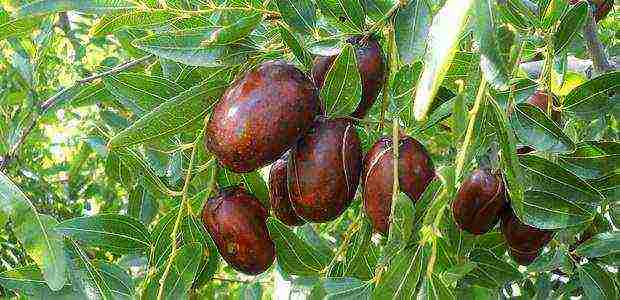
Date.

Sinit.
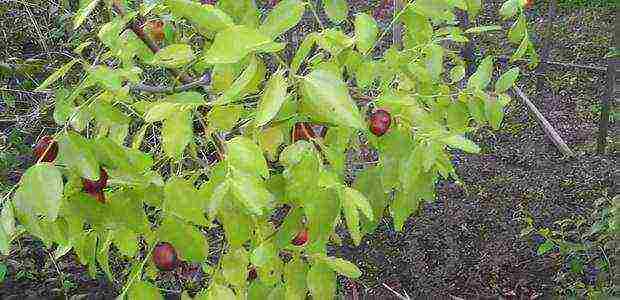
Chinese 2A.

Soviet.
Date it is considered the best variety in terms of fruit taste. Long dates (3-4 cm) are cylindrical. The outside is brown and the flesh is sweet greenish in color. The tree bears fruit in mid-September. The only negative is that the crop must be harvested immediately, otherwise the heavy fruits will crumble.
Ziziphus variety "Sinit" You can give the following description: the variety bears fruit early (late August-early September), dates weighing up to 5 g have a sweet and sour light green flesh. The biggest plus is that the fruits are light, so that harvesting can be done at any time - not a single branch will crumble.
"Chinese 2A" - frost-resistant variety. Withstands cold up to -30 C °. The beautiful small crown of a rounded shape allows you to grow it both in the open field and in a pot. The fruits are quite large - up to 15 g. They resemble a pear in shape. Only they taper not at the base, but at the end. The tree bears fruit late - at the end of October. Dates are deep brown in color with dark green sweet and sour pulp.
Look at the photo, on it the ziziphus "Chinese 2A", the description of which is given above. A neat crown looks good in any garden:
"Soviet" - a variety that produces large oval fruits. Very sweet dates, almost invisible sourness. Fruiting relatively early - in late September and early October. Minus - dates crack if not collected in time. Overripe fruits are suitable only for canning.
Planting and caring for ziziphus in the open field, taking into account the frost resistance of the tree
The plant is unpretentious. But how well it will grow and bear fruit depends on the choice of location. Warm areas in a draft-free area work well. Lighting is also important for the Chinese Ziziphus tree. If there is even a little shade in the place where the seedling will be planted, the growth and development of the plant will slow down very much, or may even stop altogether. Moreover, if there is not enough sun, the tree will not bear fruit.
The plant perfectly tolerates direct sunlight and even drought. Even at temperatures above 40 ° C and without regular watering, the leaves do not dry out, and the fruits continue to grow normally.
The frost resistance of the Ziziphus tree is also quite high. Depending on the variety, the plant can withstand cold temperatures from -15 to -30 C °.The varieties "Ta-yang-tszao" and "Chinese 2A" are considered the most resistant to cold weather. Given this characteristic, you can not really care about the winter shelter of the tree.
There will be no problems with the soil either - any soil is suitable for this tree. Loamy soils are best for the plant, but also grows well on black soil and gray soils. In the open ground, on which a fruit tree had been growing for a long time, the Chinese date will bear fruit poorly, since the soil is dry and depleted.
If such a place is the only convenient place for planting the Chinese ziziphus date (unabi), it is necessary to fertilize it well with humus and phosphate mixtures. It is necessary to dig up a plot of 3 by 3 m with fertilizers and humus, and then leave it for autumn and winter. Then the soil will be relatively suitable for unabi to bear fruit. Subsequently, you need to regularly "feed" the tree with mineral fertilizers and spud it with fallen leaves.
If the soil is very fertile, then the leaves and side branches will grow strongly on the date. They will need to be pruned regularly so that they do not darken the fruitful parts of the tree.
The ziziphus date, also known as unabi, is not susceptible to diseases and pests. It has a high ability to regenerate - after damage (fractures, pests, prolonged drought), the bark and crown quickly recover.
Another argument for growing this tree in open soil is durability. Many live for over 100 years. They actively bear fruit for about half a century, for another 25 years, the amount of the crop decreases by 30-50%, but the fruits remain the same in taste.
The growing season for the Chinese date, known as the unabi tree (ziziphus), begins in late spring. Usually this is the last third of April - the first half of May. Only with the onset of summer does the tree bloom and pleases the eye for 1-2 months. And only in August does the plant bear fruit. The first dates can be enjoyed within 2-3 years after planting in open ground.
Propagation of ziziphus by seeds and cuttings
The tree can be propagated using seeds, cuttings, as well as by grafting or planting root suckers. The best way is to plant green cuttings, but this is not always possible.
Planting and caring for ziziphus seeds in the open field is a fairly simple matter for an experienced gardener. For the winter, seeds are planted in the ground. At the very beginning of spring, the site is covered with a film.
In order to grow a seedling, you need to graft the cutting on a fruitful tree in a year. It is advisable to do this in a warm, non-dry period (May or August). If the stalk was grafted in the spring, then the seedling will reach a height of half a meter in the fall. It can be planted in a permanent place. If the vaccination was in August, then by the cold the cutting will be no more than 20 cm and may freeze.
Reproduction of the Ziziphus tree by cuttings is carried out as follows. On the stem of the stock 10 cm above ground level, the wild is cut off. On the north side of the tree in the direction of the wild, a 2 cm long incision is made, into which the cutting is inserted. There must be one bud on the handle. The place is wrapped with foil or tape, and the grafted plant is spud up to almost half the length. It is better to cover the top of the cutting with garden pitch.
Growing a ziziphus tree and caring for it involves the formation of a sufficiently voluminous crown. It is necessary to cut the tree so that around the leader trunk, which is about 15 cm higher than the side branches, there are wide branches growing in a cascade.
You can prune when the tree reaches a meter in height. This is approximately 2-3 years after disembarking to a permanent place. When the date begins to bear fruit, it is necessary not only to prune the lateral branches so that they do not suppress the main trunk, but also to thin out the crown.
Planting and growing ziziphus at home
The cultivation of the Chinese date tree (ziziphus) can also be carried out in a pot. This is an excellent plant for winter gardens, insulated verandas and loggias.
You can grow it at home by germinating a soaked bone under a film in moist soil. Next, the plant needs to be transplanted into a small pot. At a young age, a transplant is carried out annually, from 4-5 years - once every 3-4 years. The transplant is done while preserving the earthen coma. The pot should be larger than the previous one by 15-20 cm in diameter. After transplanting, the soil is watered a little, and the pot is placed in the sunniest place.
It is best to transplant into soil flavored with phosphate fertilizers. Then the root system will grow better.
For planting and growing the Ziziphus plant, a mixture of leaf and sod land, coarse sand (1: 1: 1) is suitable.
The Chinese date is not afraid of the direct sun, but it can grow in the shade. In winter, the temperature should be between 5-10 ° C. In summer, the plant can be taken out into the garden, balcony or terrace. Easily tolerates dry indoor air. Moderate watering is required in summer, minimal in winter. Do not allow the soil coma to dry out.
Planting a ziziphus and subsequent care for it will not do without the use of fertilizers. Since the soil in the pot is closed and cannot be restored in the usual way, minerals and humus are needed. Top dressing is carried out with full mineral fertilizer once a month from April to August. Garden leaves can be used as humus, and in winter and spring, peat is added to the pot every two months.
In order to better understand how to care for a tree in indoor conditions, watch the video, which tells about ziziphus in great detail:
This plant will be a real gift for a gardener who loves exotic beauty and cares about his health. The Chinese date, also known as unabi and ziziphus, is a tree or shrub, which is distinguished by its original appearance. And its fruits are not only very tasty, but also healthy. In addition, the leaves, even the bark and roots of unabi, contain medicinal substances. It can grow on the poorest land; it does not need special care. Although there is a significant problem - the Chinese date is too thermophilic, and not all varieties tolerate Russian frosts without loss. Therefore, until recently, unabi were grown only in the southern regions. But if you choose the right variety, you can get your own dates in harsher climates.
Unabi-ziziphus: what an exotic
For most of us, unabi is an exotic plant. However, in the East he has been known for a long time. According to some sources, in China and India, zizyphus was domesticated two thousand years ago. A little later, they began to grow it in Mediterranean countries. And only in the last century the Chinese date began to grow in Uzbekistan, Turkmenistan, Transcaucasia, in the Krasnodar Territory, Crimea and in the south of Ukraine.
Unabi is the champion in terms of the number of titles. In different countries, he acquired not one, but several names at once. In total, there were about a dozen of them: ziziphus, zhuzhuba, juyuba, chapyzhnik, chailon, anab, chilion, jilan dzhida, planjiba, zao, yanap (or anab), arnap, ilan dzhida. In France, the plant is called breast berry, and in Russia, the Chinese date.

In China, unabi is called the tree of youth for the ability of its fruits and leaves to rid the body of toxins, cholesterol, cleanse blood vessels and strengthen capillaries
The native climate for unabi is the tropics and subtropics. For a long time it was believed that this plant does not survive and does not bear fruit in central Russia. But in recent years, more winter-hardy forms have appeared, and gardeners have adapted to growing thermophilic exotics in a continental climate.

New cold-resistant forms of the subtropical Chinese date can also be grown in the middle lane
The Chinese date in culture is a small deciduous tree (up to 5 meters) or a tall shrub. On slightly drooping shoots, there may be rare thorns. Leaves are oval, with characteristic longitudinal veins. The crown is harmoniously shaped, pyramidal or spherical. Unabi is distinguished by a late start of the growing season. The plant wakes up by mid-May and even a little later.Therefore, return frosts are not afraid of him.
Most varieties of zizyphus require cross-pollination, so 2-3 trees should be planted side by side to get a good harvest.

On the same branch, a ziziphus can have flowers and fruit ovaries.
Unabi bloom is extended, greenish-yellow flowers bloom for one and a half to two months. They're not very good looking, but they smell great. Bees find this smell very attractive. The fruits are tied and ripen unevenly: the former can ripen by the end of summer, the latter in October, or even in December. If the autumn is rainy, the harvest is harvested unripe, and the ripeness of the unabi picks up later; in dry autumn, gardeners recommend not to rush to harvest, but to let the fruits wither on the branches - then they become tastier. By the way, up to 25 kg of harvest can be removed from one adult tree, and there are record-breaking varieties that yield 80 kg each.

Most unabi varieties give high yields.
The fruits of different varieties of unabi differ significantly from each other. Their weight ranges from 2.5 to 35 grams. The shape can be spherical, oval, pear-shaped. Color from red-orange to chocolate brown. On the skin of some varieties, light specks are visible. Ripe fruits are tender and juicy. The pulp, sometimes mealy, sour and sweet tastes are combined in different variations. The stone is small, in some varieties it does not develop completely, remaining semi-soft.
Dried unabi fruits are very similar to real dates.
The Chinese date (or unabi) has nothing to do with the real date. The plant got its popular name due to the external similarity of the fruits and a slightly similar taste.
Unabi fruits are eaten fresh, they are used for making preparations (compotes, jam, syrup, candied fruits) or dried. In any form, Chinese dates are good for your health. They contain more ascorbic acid than citrus fruits, as well as flavonoids, pectin, carotene, rutin, iodine, cobalt and other elements.

Fruits of different varieties differ in color and size, but are equally useful
Ziziphus fruits help with respiratory diseases, hypertension, anemia, vitamin deficiency. To lower blood pressure, Chinese doctors advise eating 20 fresh or dried dates three times a day after meals. The fruit decoction soothes and helps restore healthy sleep.
Birds can nibble on unabi crops. To protect it, a net is thrown over the trees.
Sweet and sour ziziphus fruits resemble dates, pineapple and pear at the same time
From the leaves of unabi, bark and roots (rich in tannins, saponins and rutin), healing agents are also prepared, which are used internally and externally. The broth has a diuretic, expectorant and antibacterial effect.
Video: why unabi (ziziphus) attracts gardeners
Description of popular varieties of ziziphus
There are about forty species of plants of the buckthorn family in the Unabi genus. On the basis of the present zizyphus, most cultivars have been bred, which are divided into two groups according to the size of the fruits (small and large-fruited). Unabis were selected by Chinese, Central Asian, Krasnodar and Crimean biologists. Scientists have noted a number of interesting features. For example, they found that small-fruited plants contain more vitamin C and tolerate lower temperatures better. Larger varieties are sweeter. But the size does not affect the yield. Unabi are divided into three groups according to the ripening time of the crop: early, middle, late.
Early
From trees of early varieties, they begin to harvest at the end of August, and end in September. These dates are generally small to medium in size. Large-fruited early varieties are rare.
Vakhsh
Bred by Tajik breeders. The tree is tall (4–5 meters), with a pyramidal crown, medium-sized fruits (up to 18 g), ripen in mid-September. They resemble a cylinder, with a light chocolate skin. The variety has a high yield.
Vakhsh is an early and high-yielding variety of unabi
Maury Jer
Ziziphus of the Mori Jer variety is the result of the labors of breeders from Moldova. The tree itself is medium in size, and the fruits are large (up to 35 g), elongated-cylindrical. They are gaining ripeness by the second decade of September. The plant can withstand temperatures as low as -25 ° C.
Mori Jer unabi can withstand short-term frosts
Chinese 60
This is one of the smallest unabi varieties. Crown diameter - no more than one and a half meters, height - up to 3 m. Fruits are elongated, slightly pointed at the top and bottom, small and medium-sized (up to 12 g), covered with a brown-plum skin. They taste sweet and sour. Harvest is ready to be harvested in mid-September.
Chinese 60 is the most compact variety with spindle-shaped fruits
Candy
This unabi gives stable and high yields by mid-September. The tree is low, with a spherical crown. The fruits are small, weighing only 6–8 g, but there are usually so many of them that you cannot see the greenery. The thin, brick-red skin covers the very sweet and juicy flesh.
The Candy variety justifies its name with an abundance of sweet fruits.
Sinit
Ziziphus variety, bred by scientists of the Nikitsky Botanical Garden. A tree of medium height with a branched crown. Fruits are medium-sized (up to 6 g), but ripen at a record early date. Cinita is harvested in late August or early September. The stone is small, sour-sweet flesh hides under a brown strong skin. The fruits are good fresh, suitable for drying and canning.
Crimean variety Sinit gives a record early harvest
Khurman
This is one of the most productive and at the same time large-fruited varieties of unabi. From flowering to ripening, an average of 80 days pass. The collection of fruits takes 2-3 weeks. The warmer and sunnier the summer was, the sweeter this Chinese date will be.
Large fruits of the Khurman variety, which ripen very early, can be harvested for 2-3 weeks
Southerner
The author of this variety is the breeder Massover BL Zizifus grows up to 4 meters. The crown of the tree is spreading. Pale brown large fruits (up to 20 g) in appearance slightly resemble a pear: at the top they are narrower than below. The pulp is a little dry, but the taste is pleasant, sweet, with a slight sourness. The Southerner variety is fruitful. The fruits are stored after drying for several months.
The pear-shaped unabi fruits of the Yuzhanin variety are dryish, but they are stored for a long time
Ta-Yan-Zao (other names - Lang, Chinese 1)
Early (reaches ripeness in the second half of September) and large-fruited unabi from China. One of the first cultivars. This vigorous, branched tree begins to bear fruit in the 2-3rd year. Dates are large, average weight 15 g, maximum - 35. In shape, they are similar to miniature pears, yellowish or brown with a red tint. The taste is sweet, the pulp contains up to 35% sugar. Very often the fruit has no bone or it is poorly developed. The yield is average. Ta-Yan-Zao is very sensitive to moisture. Due to rainy weather, the fruits become too juicy and cracked.
The name of the variety Ta-Yan-Zao in translation from Manchu means "be healthy"
Video: acquaintance with ultra-early unabi growing in Belarus
Mid-season
Chinese dates of these varieties pick up sweetness and are ready to leave the tree at the very end of September or October. They produce medium to large fruits. Low temperature resistance for most of these varieties is average.
Shirvan
This variety was bred in Central Asia. Fruits are small (average weight 3.5 g), barrel-shaped. The color of the skin is pale brown, the flesh is dense, milky-chocolate, sour-sweet. The variety gives high yields.
The Shirvansky variety gives very beautiful, but small fruits.
Absheron
Ziziphus Apsheronsky was created by Krasnodar breeders. They managed to develop a fruitful and frost-resistant variety for their region. The average weight of fruits is 6–8 g. They are chocolate-brown in color and resemble real dates. The pulp is tender, vanilla in color, the taste is bright, combining sweetness and slight sourness.The full ripeness of the fruits occurs by the second half of October.
Apsheronskiy is a variety of Russian selection with a bright fruit taste, similar to real dates
Chinese 2A (or 52)
A proven variety with nearly a century of history, it is well known in the world. From China first came to America, and only then to Russia. Large (up to 25 g) fruits ripen by the end of October. When ripe, oval-elongated dates acquire a rich chestnut color. The light pulp is juicy and sweet. The sour taste is poorly expressed.
Chinese 2A - one of the first cultivated varieties of unabi
Soviet
The medium-ripening variety was bred by botanists of Tajikistan, spread in Central Asia. Now you can buy it in Russian nurseries. Elongated-rounded fruits weigh on average 15–20 g. They are light brown in color. The pulp has a delicate consistency, harmonious taste. The disadvantage of the variety is that with high humidity during ripening, the fruits may crack.
Delicate soft fruits of the Soviet variety can crack with excess moisture
Tasty
The trees of this variety of Ziziphus grow very quickly. The fruits are large, up to 35 g in weight, ripen in October or November. Under the light brown skin, there is a sweet creamy flesh. The yield and frost resistance of the Lakomiy variety are average.
A fast-growing tree of the Lakomyi variety bears large fruits
I-Zao
This Chinese variety cannot boast of large fruits, their weight is usually no more than 7 g. But its advantage is abundant harvests. There are no thorns on a tall tree, and by mid-October the branches are hung with fruits, the color of which gradually becomes chestnut. Their greenish flesh has a pleasant sweet-sour taste. The variety is suitable for fresh use, good for harvesting.
Ya-Zao is a variety that gives a bountiful harvest in almost any conditions.
friendship
One of the newest unabis. The fruits are not the smallest, but not large, the usual weight is 10-15 g. Their shape is pear-like, and the color is unusual - plum-chocolate. The yield is low. The peculiarity of the Druzhba variety is that its resistance to frost is slightly above average.
Pear-shaped fruits of unabi Friendship of an unusual color - plum-chocolate
Tavrika
The now popular variety of Ziziphus, which ripens in October. "Dates" Tavriki are spherical or similar to barrels. Their average weight is 12-16 g. Skin color is orange-chestnut. Pulp with a characteristic pleasant taste. This variety is distinguished not only by good resistance to frost, but also by increased productivity.
Frost-hardy Taurica has round, bright fruits
Late
There are not so many varieties of ziziphus, the fruits of which ripen late. It is not very popular because the harvest is delayed until late autumn. It starts at the end of October and ends in November and sometimes in December. It happens that a tree completely sheds its foliage, the first snow falls, and the dates have not yet been collected. Of course, such a tree looks elegant and original. But only gardeners living in the hot south can afford such a luxury.
Kara-Dag
The variety created in Crimea fits well with local conditions. It tolerates dry summers and slightly frosty winters without any problems. Large pear-shaped fruits, their weight can reach 35 g, ripen by October-November. But gardeners are in no hurry to pluck them. They wait for the reddish-chocolate skin to wrinkle slightly. Dried fruits are tastier and sweeter than juicy ones. And besides, they are stored longer.
The fruits of the unabi Kara-Dag are left on the tree until the skin wrinkles: this way they will become sweeter and will last longer.
Koktebel
Another unabi variety with Crimean registration. Breeders of the Nikitsky Botanical Garden can be proud of their pet. Dates of the Koktebel variety grow not just large, but huge, they gain weight up to 50 g. Fruits are round, irregular in shape. Pistachio-white flesh is hidden behind the orange-brown skin. It is not too juicy, but with a delicate sweet-sour taste.But the harvest begins to ripen by the end of October, and northerner gardeners run the risk of not waiting for it. And in all other respects unabi Koktebel is a beautiful strong tree. By the way, its yield is also amazing. The authors of the variety assure that up to 80 kg of fruit can be harvested from an adult plant.
Koktebel is a fruitful, but late variety that can only be grown in the south.
The best varieties of unabi for Crimea
Ziziphus is very fond of warmth and light, he is not afraid of drought. Therefore, this plant feels great on the Crimean Peninsula. The Chinese date will grow even on dry and poor soil. True, lack of nutrition will affect the volume of the crop.
Even in a dry summer, unabi fruits will be tasty, but without watering, the harvest will decrease.
Any variety of ziziphus is suitable for Crimean gardens. The gardener only needs to decide what is more interesting for him to grow and when he needs a crop. Of course, the best choice is the late unabis of the Crimean selection. These fruits can be harvested when winter has already come, there will be a wonderful vitamin dessert for the New Year's table. And dried Chinese dates can be eaten until the first summer berries ripen.
Varieties for Ukraine
Almost all varieties of unabi can be grown in the southern regions of Ukraine. Mild winters and long hot summers are what exotics will like. However, the further north you go, the less choice you have. Late varieties will not be able to harvest until the onset of cold weather. When the frost touches the fruits, they will lose their keeping quality. Therefore, it is necessary to choose unabi with medium or early ripening of fruits. For example, varieties Druzhba, Tavrika, Candy, Apsheronsky, Chinese 60. It is better to give preference to small-fruited varieties. They are more resistant to frost.
Ziziphus (or unabi) adorns the garden all autumn
In the middle latitudes, cultivation of unabi is associated with certain troubles. First of all, you need to choose the right landing site. It should be well lit and quiet, protected from drafts.
A young tree on the eve of winter must be insulated by tying the trunk and crown with covering material. And the roots must be covered with foliage, grass, and then snow. If the twigs do freeze, the unabi quickly recovers. And with age, the Chinese date becomes more hardy.
Video: how to prepare an unabi seedling for winter
Frost-resistant varieties of unabi for the middle lane
The Chinese date has moved beyond tropical and subtropical regions. It is now cultivated not only in the Crimea, in the south of the Krasnodar Territory and Ukraine. Recently, gardeners living in the Dnepropetrovsk, Rostov, Voronezh regions and even in the Moscow region and Belarus talk about their successes in growing unabi. Although they admit: they have to tinker with a delicate tree, and they do not manage to harvest a good harvest every summer.
Chinese dates, especially dried dates, can be stored for a very long time.
Experienced gardeners are advised to choose early varieties with small fruits for the middle lane, they are more hardy. It is worth paying attention, for example, to Unabi Chinese 60 and 2A, Khurman, Candy, Yuzhanin, Sinit. And to form from them not a tree, but a bush with a wide crown. Such a plant is easier to prepare for frost.
Unabi fruits can ripen when all the leaves have already fallen
In the event that the fruits do not have time to ripen, the crop will still have to be harvested before the first cold weather. And then put the Chinese dates in storage and wait for ripening.
Video: unabi in cool climates - from planting to harvest
Reviews of gardeners about unabi
In Crimea, this fruit tree began to be planted relatively recently. Having tasted the taste of ziziphus for the first time, I was pleased with it, and my mother-in-law planted it in her garden, and now every September-October we enjoy its taste. I can say that not everyone likes these fruits. They remind me of something sweet and sour apple. I love the hard fruits of the ziziphus, and my mother is soft - almost dried. In its soft form, ziziphus resembles a date, and many take it for a date itself.
My slightly prickly unabi, with leaves that look like a dogwood tree, is more than 7 years old, and interest in it has not disappeared until now. This tree is about 6 meters tall and bears fruit every year, regardless of frost or summer heat. The plant tolerates frosts down to minus 25, does not require pruning.
I don’t know about others, but my craving for ziziphus completely disappeared. I read about the usefulness and goodness, bought five varieties of early ripening (by the way, I could hardly find anyone who had it, at that time it was a rarity). I don't remember the names of the varieties. The taste is so-so, prickly to the point of impossibility, after five years the root shoots begin to climb. The plants themselves were grafted, and the shoots were rushing wild, with huge thorns. Uprooted all this charm, both hybrid and wild. But that was not the case, I had to use herbicides. Now also keep in mind, it may freeze, the first three years were covered for the winter. Then she tried to fuse this good to at least someone, the only condition was that they would dig it up themselves. Even for nothing, no one was flattered. How they uprooted it is a special epic. The usual procedure for sawing off branches has turned into a tragicomedy due to the needle-sharp thorns. Since then, I have been an ardent opponent of Ziziphus. Maybe I was so unlucky, while others have a complete understanding with Ziziphus.
I planted it too. The taste, of course, is nothing special, but I don't like grapes and apples. But very useful and curative. When you eat every day, you can feel the health benefits - even outwardly noticeable. As for vitamins - there is nothing to say - one berry replaces a kilo of apples. Thorny - yes. But after all, we grow roses, sea buckthorn, raspberries, and prickly gooseberries. That's about the growth - puzzled. I haven’t had it in 3 years, but now I know and will transplant further away. And the bush is beautiful - openwork, spreading. Well, I like it. There will be shoots - I will plant more.
Unabi has been growing in my garden for the 3rd year. Such a pretty tree up to 1.5 meters. Stocky, everything is sprinkled with fruits. Ripen in October. The fruits are sweet, I add to the porridge. When my head hurts, I chew a couple of pieces or drink tea - everything goes away. There are few thorns, the rose has much more. I advise everyone!
I learned about unabi a long time ago. I read the article by D.A. Globa-Mikhailenko "Yuyuba - unabi - Chinese date" in the collection "Forest and Man" for 1986 (p. 131). Interested in the healing properties of its fruits. Here is an excerpt from the article: “The wide cultivation of jujube is facilitated by its low demand for growing conditions. It tolerates a humid and dry climate and even drought well, is not demanding on soils, withstands heat 40 and frosts down to -30. It is easily cultivated by seeds and cuttings, and begins to bear fruit in two or three years. In the reference book "Trees and Shrubs" A.A. Kachalova 1970 (p. 110) says: “Z. jujuba, European, common, unabi, jiland-dzhida (Kazakh.), French breast berry ... deserves a test in Transcarpathia ... ". That's what confused me ... Yes, this is a "rake", I understand, but in May I will compactly transplant 10 of my seedlings into the sunniest and most protected place of my site and I will take care of them ... whatever happens! We have snow cover from 0.5 to 1 m. I will try to protect it.
This year my unabi finally gave a tangible harvest compared to previous years. Enough to add to the jam, and to the tinctures, and so to eat. Just a tree, and he is already 7 years old, came into force. This year I did not even water or fertilize it, I made a mistake during cultivation - it is very high for me, about 5 meters, it is difficult to harvest and difficult to cut, tk. very hard wood.
Two unabi trees have been growing in Central Ukraine for eight years, however, small-fruited, large-fruited froze out. They have been blooming for several years and are bearing fruit little by little. There are a lot of flowers, which the bees are incredibly happy about, and there were about a dozen ovaries the year before last, last summer there were fewer, but the fruits are small and tart in autumn (later planted, still grafted from the Nikitsky Botanical Garden).
Unabi is an extremely useful and beautiful plant, but most gardeners know little about it.It is believed that Chinese dates can only be grown in the south. Indeed, there unabi thrives and bears fruit without much hassle. But it can be cultivated in more northern regions as well. You just need to pay attention to the choice of the variety and put a little work into it.
Unabi, ziziphus, or Chinese date: the most popular varieties of exotic plants from yagodka.club.
